In the course of my career as an EE specializing in Ultra Wideband radio, radar, and antenna hardware, the need often arises for a useful and easy to reproduce UWB antenna.
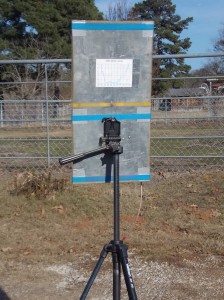 This antenna has been a work-horse, has a bandwidth of roughly 200 MHz, and operates efficiently from 200 MHz to a bit over 400 MHz. In addition (although not formally measured) phase linearity is good and there is virtually no ringing in the time domain.
This antenna has been a work-horse, has a bandwidth of roughly 200 MHz, and operates efficiently from 200 MHz to a bit over 400 MHz. In addition (although not formally measured) phase linearity is good and there is virtually no ringing in the time domain.
SWR is low, below 1.5:1, and the radiation pattern is roughly that of a simple dipole over the entire frequency range.
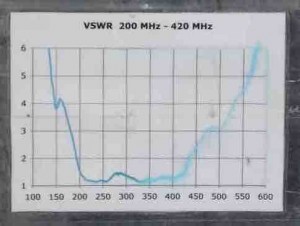 This antenna is as simple as it appears, simply 2 squares with a 1/2 inch gap, and with an SMA feed in the center. The feedline coax is choked to mitigate common-mode coax shield currents with type 61 ferrite snap-ons. The squares are 10 3/4 inches on a side, making the sizing equation:
This antenna is as simple as it appears, simply 2 squares with a 1/2 inch gap, and with an SMA feed in the center. The feedline coax is choked to mitigate common-mode coax shield currents with type 61 ferrite snap-ons. The squares are 10 3/4 inches on a side, making the sizing equation:
squares: L(in) = 2150 / fLow (MHz) per square
gap: D(in) = 100 / fLow (MHz)
EZNEC MODEL OF A 120 – 240 MHz VERSION
The size of the plates for this modeling exercise are 18 inches x 18 inches, with a 5/8 inch gap.
Using EZNec for analysis of a vertical wire frame structure, we get the following gains at 0 degrees elevation, and both broadside and edge-wise at the lower and upper frequencies of the design:
Note that gains are within 2.5 dB of each other. Also note that the model tested a bit high on the “average gain” EZNec test, so the absolute modeled values of gain shown above are suspect and are probably a bit high as well.
This is the modeled SWR curve, and is a decent match for the measured SWR curve shown for the real antenna above:
Note that the units above that I have used for years are thin single-sided copper-clad pc board attached to a thin Plexiglas sheet for a little extra strength. As such you may find that the design equations produce an antenna with frequencies that are a bit different when using different or no substrate material(s).
Feel free to use this design information for non-commercial use.
Dave Benzel – KD6RF – 2016 Dec 27
5,930 total views, 2 views today
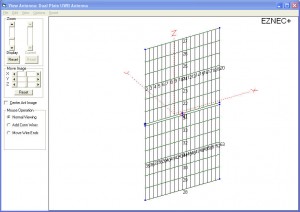
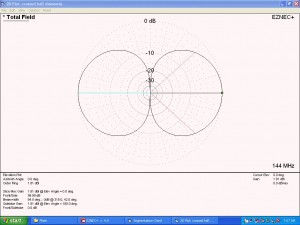
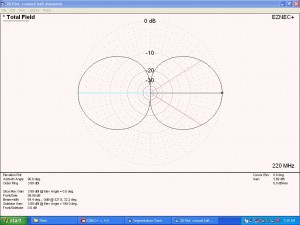
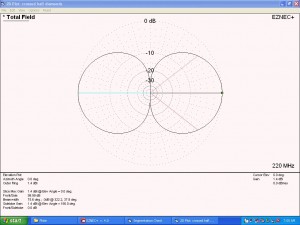
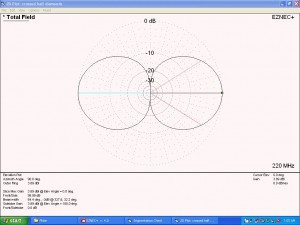
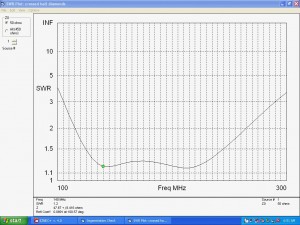
Hello:
Great web site! Was looking at a lot of things and got involved with the Wide Band antennas.
You show one that has a great pattern at 144 and up a ways. I wanted to ask if you have a design for 144 and 70cm (439MHz) for FM repeater use.
I am interested in what effect(s) the geometry has on the performance, specifically the band width.
Does the length or the width have an specific or different effect, etc. You are using squares and did not mention the aspect ratio so maybe it is not a controlling factor.
Have you done anything with STL (small transmitting loops)?
I have built my first mag loop and the results are very good.
Anyhow, thanks for putting in the time to make a great web site, appreciated.
73,
Larry Hower
VK7WLH
W0LH
I have not done exhaustive work on the *exact* best geometry for the UWB plate antenna, only enough to know that squares are quite close to the “best” in terms of low SWR over max bandwidth.